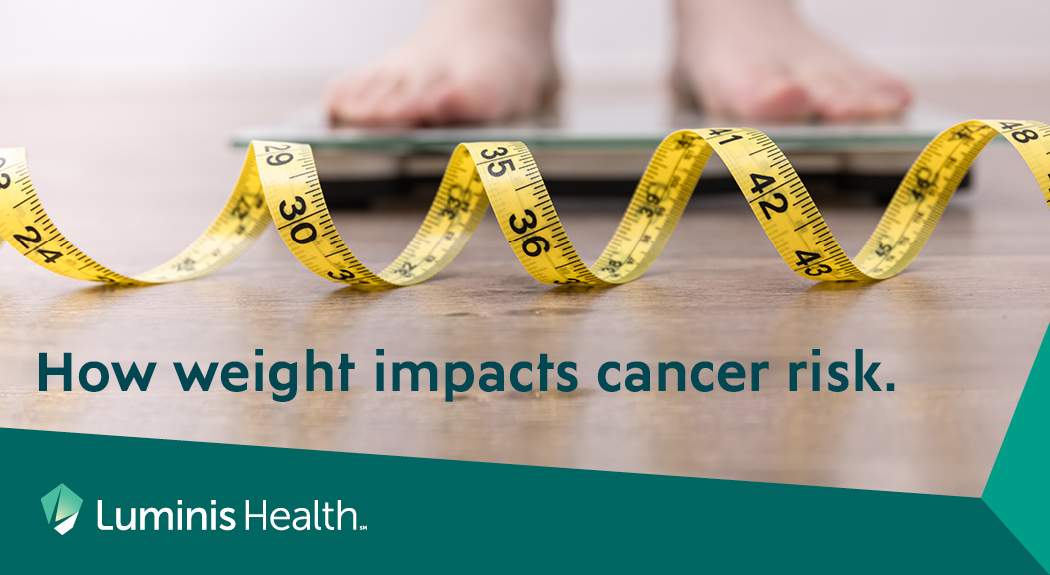Here’s some food for thought: Being overweight or obese can significantly increase your risk for many types of cancer. Obesity can also lead to a higher rate of cancer recurrence and a lower likelihood of survival. While this might be surprising news, it’s important to realize the reasons why, and with the help of Luminis Health Surgical Oncologist Dr. Naeem A. Newman, know how you can decrease your risk of developing cancer.
Which cancers are associated with obesity?
The 13 types of cancer for which obesity is known to increase the risk are:
- Breast cancer (in postmenopausal women)
- Multiple myeloma, a cancer that forms in a type of white blood cell called a plasma cell
- Meningioma, a type of brain cancer
- Cancers of the esophagus, colon and rectum, uterus, gallbladder, upper stomach, kidneys, liver, ovaries, pancreas and thyroid
The risk of getting cancer increases with the more excess weight a person has and the longer they are overweight. Experts believe being obese increases that risk largely due to the inflammation caused by the fat that surrounds your vital organs. This excess fat affects certain processes in the body, including how it manages hormones like insulin—the hormone that regulates blood sugar—and estrogen.
How does inflammation cause damage?
Inflammation caused by obesity can keep the body from properly responding to insulin. This is called insulin resistance. When the body doesn’t respond to insulin correctly, it produces more insulin to make up for that. The increase in insulin due to insulin resistance triggers an increase in the number of cells produced, which can lead to cancer.
Increased insulin also affects how hormones like estrogen are controlled. More insulin can lead to more available estrogen, which also increases the risk for cancer.
What’s wrong with excess estrogen?
Estrogen is necessary for the body to function: In women, the ovaries are the main source of estrogen. In men, an enzyme converts testosterone to estrogen. Fat cells in both men and women can also make estrogen, which is why too much estrogen is often seen in obese people. In a nutshell, higher estrogen levels lead to increased cell production, which could result in the growth of a tumor.
What is a healthy weight?
Body mass index (BMI) is used as a screening tool for being overweight and obese. BMI is calculated using a ratio of a person’s weight in proportion to height. BMI calculators are readily available online. Adults with a BMI from 25.0 to 29.9 are considered overweight. A person with a BMI that is 30.0 or higher is considered obese. It’s estimated that about 21% of all cancers that are linked to obesity could be prevented if the American adult population had a BMI of less than 25.
What you can do
There are steps you can take to prevent obesity:
- Keep moving—Aim for 150 minutes of moderate activity or 75 minutes of vigorous activity a week.
- Eat healthy—Fill at least two thirds of your plate with non-starchy vegetables, fruit, whole grains and legumes (beans and peas), and a third or less with protein. Evidence shows that exercise combined with healthy eating results in greater weight loss and the greatest impact on reducing inflammation in your body.
- Limit alcohol—Women should limit themselves to one alcoholic drink per day and men to two.
- Get plenty of rest—Fatigue can make you want to eat more and increases the chances of making unhealthy choices.
When it comes to cancer, there are some risks we can’t control, but when we know more about the risks we can control, it gives us one more reason to make healthy choices. If you are interested in losing weight, create a weight loss plan with your doctor that works for you.
 Naeem A. Newman, MD, is a surgical oncologist/general surgeon at Luminis Health. He is dedicated to a multi-disciplinary, collaborative approach to cancer care.
Naeem A. Newman, MD, is a surgical oncologist/general surgeon at Luminis Health. He is dedicated to a multi-disciplinary, collaborative approach to cancer care.



